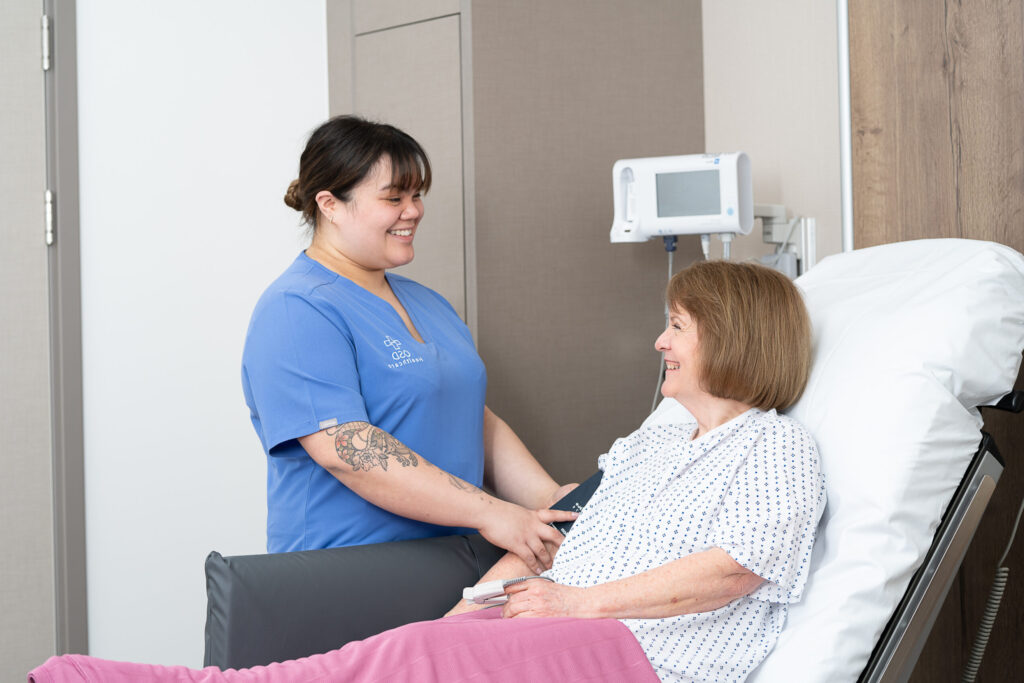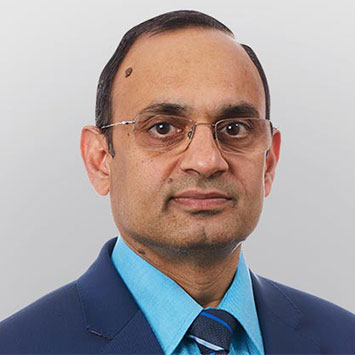What are uterine fibroids?
Uterine fibroids, also called uterine myomas or leiomyomas, are benign growths made of muscle and fibrous tissue that form in or around the uterus. They are quite common and often asymptomatic. However, when symptoms do appear, they may include:
- Painful or heavy periods
- Abdominal pain
- Lower back pain
- Frequent urination
- Pain or discomfort during sex
If a fibroid becomes significantly large, it may cause noticeable abdominal swelling.
Fibroids can grow anywhere in the uterus and vary from the size of a pea to the size of a melon.
There are three main types:
- Intramural – the most common type of fibroid. These develop in the muscle wall of the womb.
- Subserosal – these develop on the outside of the uterus and can grow to a very large size.
- Submucosal – these develop in the muscle layer below the inner lining of the uterus and grow into your womb.
In some cases, fibroids are connected to the uterus by a stalk of tissue. These are known as pedunculated fibroids.
While the exact cause of fibroids remains unknown, they are associated with oestrogen. Consequently, fibroids may shrink, particularly after menopause when oestrogen levels decline.
Please call to enquire about the price
Ways to payBefore surgery
If a fibroid isn’t causing any symptoms, it won’t need to be treated.
If you are experiencing symptoms that impact your quality of life, it is advisable to schedule an appointment with one of our skilled gynaecologists. Our goal is to offer a comprehensive service, ensuring you leave your appointment with a clear diagnosis and an understanding of your next steps.
During your visit, your gynaecologist will gather a detailed medical history and inquire about your symptoms, including when they began, whether they have worsened, and if they are new or recurring. They will then perform a physical examination and conduct an ultrasound scan to confirm your diagnosis.
If you do have a fibroid (or fibroids), the ultrasound scan will show your doctor its location, size and type.
Just because you have fibroids, it doesn’t mean you will need surgery. In the first instance, your gynaecologist will prescribe medications to address your symptoms, such as heavy periods and pain. If these do not provide relief, they may prescribe medications that aim to shrink the fibroid. One such medication is gonadotropin releasing hormone (GnRH) agonists, which can help reduce the size of fibroids before surgery.
If the medicinal approach does not alleviate your symptoms, your gynaecologist will recommend surgery to treat fibroids.
Preparing for surgery
If you decide to proceed with surgery, we will help you prepare. Leading up to the procedure, maintaining a healthy diet and quitting smoking, if possible, can be beneficial.
Inform your gynaecologist immediately if you’re taking blood thinners like Warfarin or aspirin, as you may need to adjust or stop them a week before surgery. Your gynaecologist will provide specific instructions if this applies to you. Also, let them know if you use nonsteroidal anti-inflammatory drugs (NSAIDs) such as ibuprofen. Bring any prescription medications with you to the hospital, and your doctor will advise whether you can take them with a sip of water before surgery or if they should be taken afterward.
On the day of surgery, wear loose, comfortable clothing and bring a small bag with essentials. Pack a toothbrush and toothpaste, your phone and charger, a book, and any prescription medications.
After you arrive and settle into your room, a nurse will get you ready for surgery by checking your vital signs, reviewing your medical history and medications, and confirming your emergency contacts. Before the procedure, your doctor will go over the details with you again and ask you to sign a consent form.
During surgery
There are several types of myomectomies, each with its own approach and considerations. The selection of a specific myomectomy type is influenced by factors such as the size, quantity, and location of your fibroids, along with your overall health and reproductive aspirations.
The three common types of myomectomy are:
Laparoscopic myomectomy:
A laparoscopic myomectomy is performed if the fibroids are small to moderate in size. This is a minimally invasive day-case surgery, which means you can be treated and go home after a one- or two-night hospital stay.
A laparoscopic myomectomy is done under general anaesthetic, so you will be asleep.
Then, small incisions, typically ranging from 0.5 to 1.2 centimetres, will be made in the abdomen. Trocars (hollow tubes) are inserted through these incisions to provide access for specialised laparoscopic instruments.
The abdomen will then be expanded with carbon dioxide, so your surgeon has the clearest view possible of your uterus. A laparoscope, which is an instrument with a tiny camera and light, will guide the operation. Once located, the fibroids will be removed via the small incisions. In some cases, techniques like uterine artery embolization may be used to block the blood vessels supplying the fibroids, aiding in their removal.
After the fibroids are removed, the carbon dioxide used to expand your abdominal cavity will be released, and the small incisions will be closed using stitches or medical adhesive. A protective bandage will then be applied over the incision sites.
Patients usually experience reduced pain, smaller scars, and a faster recovery compared to traditional open surgery.
Abdominal myomectomy
An abdominal myomectomy is also referred to as an open myomectomy. It may be recommended if you have many fibroids or large fibroids. The procedure involves making a larger incision through your abdomen, providing direct access to the uterus. This is normally horizontal and on the lower abdomen. However, if your uterus is larger, the fibroids are higher up or you have a scar from a previous surgery, your surgeon may make a vertical incision.
Once the fibroid(s) has been removed, the surgeon will close the wound with surgical stitches.
You will need to stay in hospital for one or two nights after this surgery and recovery will take a few weeks.
Hysteroscopic myomectomy
An hysteroscopic myomectomy is ideal for women who suffer with submucosal fibroids or have small fibroids that do not sit deep in the uterine lining. It is the least invasive of the procedures and requires no incisions.
In this procedure, an hysteroscope (a tube with a tiny camera, a light and a tool for removing fibrotic tissue) is inserted into the uterus via the vagina and cervix. The hysteroscope is then used to shave off the submucosal fibroids.
This is a day-patient procedure, so you can be treated and go home the same day. It can be performed under general anaesthetic or sedation.
After surgery
Following the surgery, you’ll be taken to our recovery area where our specialized staff will closely monitor your vital signs as you awaken from anaesthesia. If you underwent a laparoscopic myomectomy, you might experience bloating due to the carbon dioxide used during the procedure.
The recovery process will depend on the type of myomectomy you had. After the surgery, a friend or family member will need to take you home as you are not allowed to drive after anaesthesia or sedation.
After a myomectomy, you may experience:
- Cramping
- Pelvic pain
- Spotting similar to your menstrual period
- Light vaginal bleeding and discharge are common and expected for a period of 1-2 weeks following surgery
Depending on the myomectomy you had, your recovery will range from a couple of days (hysteroscopic) to 2-3 weeks (laparoscopic) or 4-6 weeks (open).
For those who wish to conceive, the timing for attempting pregnancy after a myomectomy depends on factors such as the type of surgery you had, the extent of fibroid removal, and individual healing.
It’s important patients closely follow our postoperative instructions, attend follow-up appointments, and communicate any concerns or unusual symptoms. Adhering to postoperative care guidelines is crucial for a successful recovery and optimal long-term outcomes.
Recovery and Aftercare
Recovery and aftercare are crucial aspects of the myomectomy process. Proper care and attention can help minimise complications, reduce discomfort, and promote a smooth healing process.
Immediate Post-Surgery Care
After the surgery, you will be taken to the recovery room where you will be monitored for a few hours. Your healthcare team will:
- Monitor your vital signs, such as blood pressure, heart rate, and oxygen levels
- Administer pain medication to manage discomfort and pain
- Provide instructions on how to care for your wound and manage any bleeding or discharge
- Encourage you to move your legs and take small walks to prevent blood clots
It’s essential to follow your healthcare team’s instructions carefully to ensure a smooth and safe recovery.
Long-term Recovery Tips
To promote a successful recovery, follow these long-term recovery tips:
- Rest and avoid heavy lifting, bending, or strenuous activities for 4-6 weeks
- Take pain medication as directed by your healthcare team
- Follow a healthy diet and stay hydrated to promote healing
- Avoid smoking and second-hand smoke to reduce the risk of complications
- Attend follow-up appointments with your healthcare team to monitor your progress and remove any sutures or staples
By following these tips, you can minimise the risk of complications and promote a successful recovery.
Risks and Complications
As with any surgical procedure, myomectomy carries some risks and potential complications. These may include:
- Infection: As with any surgery, there is a risk of infection, which can usually be managed with antibiotics.
- Bleeding: Heavy bleeding is a possible complication, especially if the fibroids are large or numerous.
- Adhesions: Myomectomy can cause adhesions (scar tissue) to form in the pelvic cavity, which can lead to bowel obstruction or infertility.
- Infertility: The procedure can weaken the uterine wall, increasing the risk of infertility or miscarriage in future pregnancies.
- Uterine Rupture: Women who become pregnant after a myomectomy are at risk of uterine rupture, especially if the fibroids were large or numerous.
It’s essential to discuss these risks and complications with your doctor before undergoing myomectomy. Your doctor can help you weigh the benefits and risks of the procedure and determine if it’s the right option for you. Understanding these potential outcomes will help you make an informed decision about your treatment and ensure you are prepared for the recovery process.
Appointment and Treatment Plan
Appointment
Based on your previous consultation with a doctor, an appointment will be arranged between you and your surgeon.
Treatment plan
During this appointment, you will review your medical history, discuss the details of the surgery and recovery process, and collaboratively decide if this procedure is a suitable option for you.
Pre-op assessment
If surgery is an option, then the surgeon and their team will thoroughly assess whether you’re right for the surgery. They’ll consider your current health, any previous issues, and other external matters.
Surgery
Prior to going through the surgery, our team will ensure that you’re prepped once again. If everything is confirmed, you’ll undergo the surgery and then we’ll explain the aftercare instructions.
Aftercare
If necessary, you’ll stay in a ward for a few hours to ensure that you’re ready to go home after the surgery. However, this may depend on the surgery outcome and whether you need moderate or light assistance.
Follow-Up
You’ll come in a few weeks later and we’ll give you one final check-over to ensure that you’re on track for recovery.
Experts
We are proud to provide patients with access to a wide range of clinicians, chosen specifically for their knowledge and reputation in their area of expertise. Our experts align with our values: putting you at the centre of your care and educating you on your options at each step of the journey. We encourage you to learn more about our clinicians and how they can help you below. As always, please contact our patient services team if you require any additional information.
We offer 3 ways to pay for your treatment
We exist to take the stress out of private healthcare.
Our payment options are designed to offer you easy access to our treatments and services. You can choose to pay on the day, spread the cost, or use your private medical insurance.
Our patient services team will guide you through the process, providing clear costs and support throughout your course of treatment so you can focus on the thing that matters most – your health.
Whether you pay in advance, spread the cost, or use your private medical insurance, rest assured you will be receiving exceptional care 365 days a year.
Pay in Advance
Even if you do not have medical insurance, you can still get quick and comprehensive access to private medical care.
We provide transparent pricing from your initial consultation to the completion of your treatment so you know where your stand, every step of the way.
We accept all major debit and credit cards, as well as Apple Pay for UK residents. Please note that we do not accept cash or cheques.
Pay monthly
Paying for your treatment at OSD Healthcare doesn’t need to mean settling the full cost in one go.
Many of our treatments have a pay monthly option that allows you to spread the cost of your treatment over 12 months with no credit checks required.
A minimum spend of £300 does apply. We’ll take your first payment upfront and then arrange a direct debit for your monthly payments thereafter. It’s that simple.
Pay using PMI
We are recognised by all major health insurance companies and with our extensive range of services, there are lots of benefits to using your insurance with us. Our patient services team is here to answer any questions you may have about using your private health insurance with us.
Please bring along your policy details including your scheme details, membership or policy number, expiry date and confirmation of eligibility to claim (i.e. your authorisation number). If you do not have these details with you, we will require payment from you on the day. Patients are liable for any amounts not settled by their insurer.
FAQs
Myomectomy is a surgical procedure that removes fibroids while preserving the uterus, allowing women to potentially become pregnant in the future. There are three main types of myomectomies: abdominal myomectomy, laparoscopic myomectomy, and hysteroscopic myomectomy. Each type has its own approach and is recommended based on the size, number, and location of the fibroids, as well as the patient’s overall health and reproductive goals.
Abdominal Myomectomy
Abdominal myomectomy, also known as an open myomectomy, is a traditional surgical procedure that involves making a larger incision in the lower abdomen to access the uterus. This type of myomectomy is typically recommended for women with large fibroids, multiple fibroids, or fibroids that are deeply embedded in the uterine wall. During the procedure, the surgeon makes a vertical or horizontal incision, removing fibroids and then stitching the uterine muscle layers back together. This method allows for the removal of larger fibroids and provides the surgeon with a clear view of the uterine walls. Most women who undergo abdominal myomectomy spend one to three days in the hospital and require a few weeks for recovery.
Laparoscopic Myomectomy
Laparoscopic myomectomy is a minimally invasive procedure that involves making several small incisions in the abdomen. Through these incisions, a laparoscope (a thin tube with a camera) and other specialised surgical instruments are inserted. This type of myomectomy is usually recommended for women with smaller fibroids or those who prefer a minimally invasive approach to minimise scarring and recovery time. In some cases, techniques like uterine artery embolization may be used to shrink fibroids before removal, enhancing the effectiveness of the laparoscopic approach. During the procedure, the surgeon uses the laparoscope to visualise the uterus and carefully removes the fibroids through the small incisions. The benefits of laparoscopic myomectomy include less pain, smaller scars, and a quicker recovery compared to open surgery.
Hysteroscopic Myomectomy
Hysteroscopic myomectomy is another minimally invasive procedure, ideal for women with submucosal fibroids that grow into the uterine cavity. Another option for treating fibroids and reducing heavy menstrual flow is endometrial ablation, which destroys the lining of the uterus but is not suitable for those wishing to preserve fertility. This procedure involves inserting a hysteroscope (a thin tube with a camera and light) through the vagina and cervix to access the uterus. The surgeon then uses a wire loop or other instruments to shave off and remove the fibroids. Hysteroscopic myomectomy does not require any incisions, making it the least invasive option.
Myomectomy can provide significant symptom relief for women with uterine fibroids. By removing the fibroids, the procedure can help alleviate:
- Heavy menstrual bleeding
- Pelvic pain and pressure
- Vaginal bleeding and discharge
- Abdominal pain and discomfort
In addition to symptom relief, myomectomy can also improve fertility and reduce the risk of complications associated with uterine fibroids.
By understanding the recovery and aftercare process, as well as the benefits of myomectomy, women can make informed decisions about their treatment options and take the first step towards a healthier, happier life.




